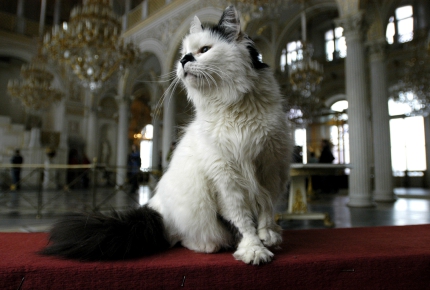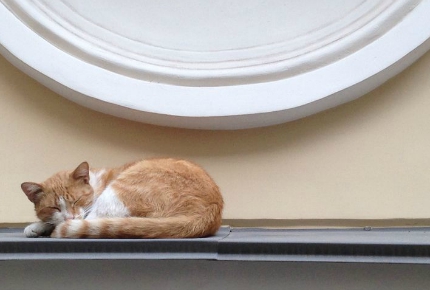Paws for thought in St Petersburg

Cats. The unsung heroes of the Hermitage Museum
Alamy / Andrey Kobylko
The labyrinthine catacombs of the Hermitage Museum are home to an army of felines, whose story is as colourful as the exhibits they guard. Gavin Haines reports.
A bit of trivia for you: if you were to spend a minute looking at every exhibit in the Hermitage Museum, you’d be there for 11 years. Or so they say. Considered by many to be the finest museum on the planet, the problem with this place is that no matter how many times you explore its endless corridors and yawning galleries, you always leave feeling like you’ve just scratched the surface. Time always defeats you. You miss more than you see.
But there is one collection in particular that most visitors never see: the family of felines living beneath the museum. Stalking the Hermitage’s labyrinthine catacombs, these moggies have an important job: to purge the museum of vermin.
"These moggies have an important job."
How good they are at this depends on who you talk to. One Hermitage security guard is said to posses a photo of a cat watching a rat drink from its water bowl. Not what you’d call a fearsome predator.
Lazy though they may be, cats have been at the Hermitage longer than most of the exhibits. For that we have Elizabeth of Russia, daughter of Peter the Great, to thank: frustrated with vermin gnawing at the furniture in her newly built Winter Palace, in 1745 she issued a decree for “the biggest and best rat chasers” to be sent to St Petersburg.
“It was necessary – there were rats everywhere,” says Maria Khaltunen, who, incredibly, is the cats’ personal press secretary.
 The Hermitage cats have even had professional portraits done
The Hermitage cats have even had professional portraits doneThe Hermitage Museum
The dutiful felines kept working throughout the Napoleonic Wars and the Russian Revolution of 1917. They even stayed on when the Winter Palace ceased to be the home of the tsars. Sadly, though, none of them survived the brutal Siege of Leningrad (1941-44).
“Most animals died – some were eaten,” says Maria, referring not just to the museum’s cats, but all animals living in St Petersburg, known then as Leningrad. Things were so bad, adds Maria, that there "were even recipes for cooking rats."
Only six cats survived the siege in the whole city – all other animals perished, along with more than one million inhabitants. But amidst the bleakness were rays of light: with the city reduced to rubble and its citizens despondent, one of those cats offered hope.
“The cat had a kitten and it was seen as a sign that everything was going to be alright – it was a symbol that the war would be finished,” Maria tells me. The siege ended shortly after.
Six felines weren’t enough to keep the vermin at bay though, and by the time the siege was lifted the city was once again infested with rats. But not for long.
"Most animals died – some were eaten."
“People sent their cats to Leningrad from across Russia to protect the city,” explains Maria, who looks after the felines with several full-time volunteers. “We have a special cat house in the basement. They have their own cat beds and a washing machine.”
A washing machine? “Yes, to put their blankets in.” Right, of course.
Truth be told, the Hermitage cats became redundant long ago: poison keeps the vermin population under control nowadays. In fact, rather than dedicated rat killers, the current cats are waifs and strays, looked after by the museum until homes can be found for them.
So how many of them roam these catacombs? “Our director permits us only to have 50 cats,” says Maria, coyly. “So officially we have 50 cats.” Nudge, nudge, wink, wink.
The Hermitage catacombs are off-limits to the public, save for one day a year, the Saturday after Easter, when cat lovers are allowed to meet the famous felines. As if there wasn’t enough to see already: well, I suppose Byzantine art can wait.
 Fearsome predators these are not
Fearsome predators these are notThe Hermitage Museum
Adopt a Hermitage cat
Adopt a slice of Russian history by rehoming a Hermitage cat – some souvenir. More details are available at www.hermitagecats.ru, but it’s Russian only so try calling them (+7 911 791 2419).
Alternatively, head to Cat Republic (en.catsrepublic.ru), a feline-themed café, library and adoption centre in St Petersburg, run by Anna Kondratyeva, the Hermitage cats' head veterinarian. There are six Hermitage felines residing at the café, which organises monthly events where you can get acquainted with cats in need of a family.
Do you have any Feedback about this page?
© 2025 Columbus Travel Media Ltd. All rights reserved. No part of this site may be reproduced without our written permission, click here for information on Columbus Content Solutions.









 You know where
You know where